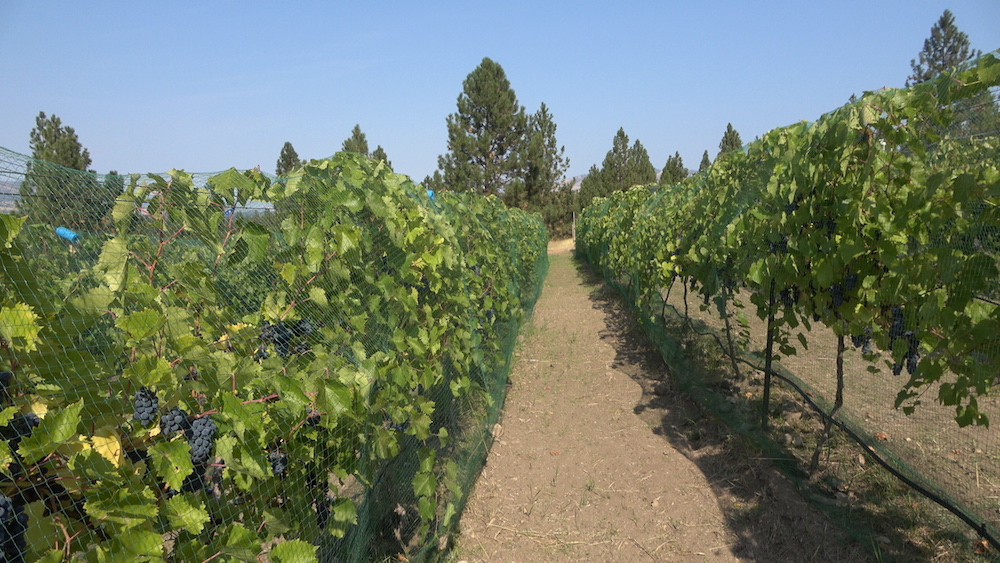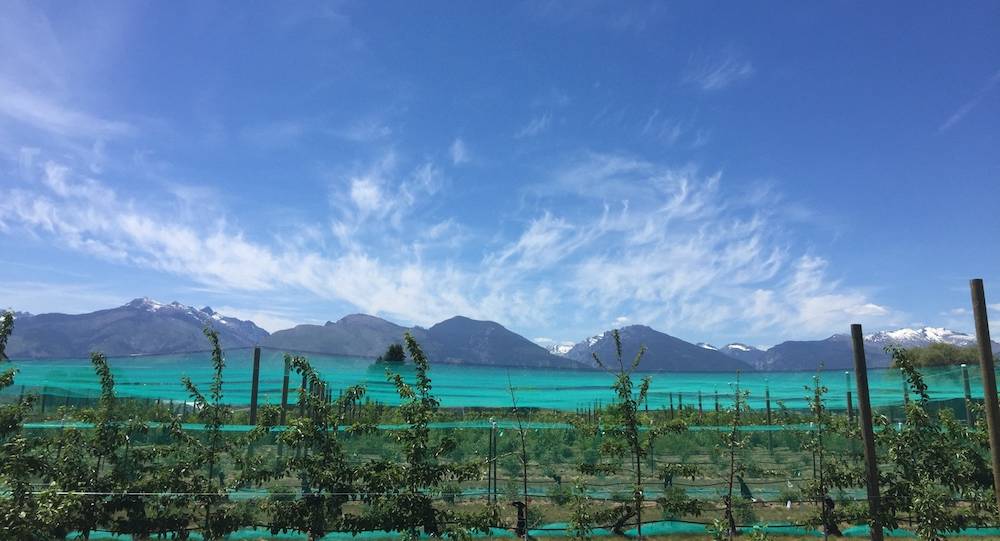Weed, Pest, and Disease Management
A great example of effective bird netting and weed control under the vines and between the rows at Luna Llena Vineyards near Florence, MT.
Multiple options are available for weed, disease, and pest control, and combining (integrating) several often provides the best control. Each option has its benefits and drawbacks.
Weed Management
At WARC, we use a combination of row cover (fescue bunch grass), pre- and post-emergence herbicides under the vines, and mechanical weeding throughout the season using tools like hoes and shovels.
Weed control between rows depends on whether you’re working with sod/cover crop or bare ground. There are pros and cons to both, some of which are discussed in the section “Weed Control and Vineyard Floor Management (PDF)” in the Growing Grapes in Minnesota manual. If you’re working with bare or cultivated alleys, you will need to cultivate throughout the season using a rototiller or tractor implement to keep weeds under control. Vineyards on steep slopes should avoid this method, as it can greatly increase erosion. An alternative is to plant sod or other cover crops between your rows, which can outcompete weeds and be easily managed with occasional mowing throughout the season. Perennial grasses tend to be ideal for Montana vineyards, as they can easily withstand our dry summers and harsh winters while growing low to the ground and competing minimally for nutrients and water.
Newly planted grape vines are very susceptible to weed competition. Weeds under the vines will compete for water and nutrients, stunting the growth of the young plants. Be sure you have rhizomatous, spreading, perennial weeds such as quack grass, field bindweed, and Canada thistle under control prior to planting, and continue to be very diligent about weed control for the first year after planting. Once plants reach mature size, they’ll be better equipped to handle weed competition.
Weeds growing under vines can be controlled through both mechanical and chemical methods, and ideally a combination of both. Mechanical weed control options include hand weeding, hoeing, and tilling around the base of the plants. These options are more labor intensive and tillage can damage shallow roots. Like all weed control methods, mechanical weed control is most effective on small weeds. Don’t wait until the weeds are large to remove them. They are hard to remove and have done most of their damage to the vines once they reach mature size.
Physical barriers such as mulch or weed barriers (e.g. landscape fabric) are also effective tools for controlling weeds. Mulch must be 4-6 inches deep to control weeds and is only effective on annual weeds. It is also important to move mulch 2-4 inches away from the base of the plants to prevent suffocation and pest accumulation. Weed barriers can control both annual and perennial weeds. Barriers are expensive on larger scales and can interfere with fertilizer application. Mulch and weed barriers also can provide habitat for small mammals likevoles and pocket gophers. These small mammals can do a lot of damage, especially in the early stages of establishment, by feeding on roots and trunks and digging out the young plants.
Herbicides are effective if used correctly, and often provide the lowest cost weed control. To use herbicides effectively, you must read and understand the label. Only certain products are approved for use in grapes, and this information can be found on the pesticide label. Herbicide-based weed control for fruit plantings often combines two types of herbicide: pre-emergent and post-emergent. Pre-emergent herbicides kill annual weeds before they emerge and are applied in the late fall or early spring while fruit plants are dormant and require incorporation into the soil with water (rain or irrigation) or tillage. The active ingredients Dichlobenil (Casoron) and Flumioxazin (e.g. Chateau) are pre-emergent herbicides that are approved for use in grapes, and there are quite a few more listed below. These pre-emergent herbicides cannot be used in the first year after planting, but are safe and effective for established plantings. Pendimethalin (Satellite Hydrocap) can be used in new plantings for grapes.
Post-emergence herbicides are applied to actively growing weeds. There are several types of herbicides that will control grassy weeds that are labeled for grapes, including Clethodim and Fluazifop-p-butyl, among others. The most effective way to control broadleaf weeds with herbicides is spot spraying with contact herbicides. Contact herbicides kill the green plant tissue they contact but are not taken up into the plant and thus provide lower risk of crop injury if you accidently contact the crop. These include all organic herbicides and synthetic herbicides such as Glufosinate-ammonium (e.g. Rely, Cheetah). Glyphosate is approved for spot spray use in grapes, but as with pre-emergent herbicides, they should be used when the vines are dormant. Glyphosate is a non-selective systemic herbicide (taken up and moved within plant tissues) and can be an effective tool to control perennial weeds like thistle, quackgrass, and field bindweed.
The Growing Grapes in Minnesota guide features a helpful list of herbicides that are labeled for grapes, and you can also find more herbicides that are appropriate for new vine plantings in this article from University of Minnesota’s Enology Department (Annie Klod, 2019). The University of California’s Integrated Pest Management Program also offers detailed information on herbicides labeled for grapes, along with recommendations for applying the herbicides to the best effect.
Insect and Other Pest Management
Birds
WARC uses an overhead bird netting system — a large investment up front, but one that saves a lot of pain in the future. You can also opt for the less expensive over-the-vine bird netting option, as pictured at the top of the page.
As with many fruit-bearing plants, birds can become a persistent pest as your vines put on fruit and become an appealing food source (note: grapes do not need to be ripe for birds to take interest). The most common method in Montana for protecting grape vines in lead-up to harvest is through various netting systems. Some vineyards may want to invest in large nets that sit high above the vines, which allows ample space for equipment use (like mowers and tractors) and easier working conditions for laborers (i.e. they can easily move in and out of the netted area, while being able to fully stand up under the nets). Another option for netting is to drape nets directly over the vines. While this option is usually much cheaper and less labor-intensive to set up than the larger netting systems, growers may find that birds can still find their way under and through the nets. If you choose this system, be sure to secure the bottoms of the nets underneath the vines, and try to keep the net at least a few inches away from the fruit (birds are known to sit on the net and poke their heads through to get to the fruit). There are a number of less common systems that employ alarms, lasers, and even mimic various bird distress calls to discourage their feeding, but these are typically best used in conjunction with nets for greater success rates.

Fresh pocket gopher mound, a sure sign you need to start considering your control options. (Photo courtesy of Northwest Center for Alternatives to Pesticides.)
Voles & Pocket Gophers
Voles and pocket gophers are very common pests of any garden, yard, or horticultural operation in Montana. These rodents both burrow underground and feed on plant materials like roots, tubers, and emerge above ground to feed on a plethora of vegetation, including the bark of shrubs and trees, often girdling plants. Both species tend to reproduce multiple times a year, so it’s especially important to pay attention to signs of their presence in your vineyard and act early. The best management plan for voles and pocket gophers includes prevention - that is, avoiding creating ideal habitats for them in your vineyard. You can achieve this through simple practices like mowing, keeping weeds at bay, and keeping ground cover out of the direct radius (~1-2 feet) of your vines. If you have already seen evidence of their presence - e.g. characteristic dirt mounds, exit holes for tunnels, or trails cut into the grass/soil (typically found in spring after snow melts) - you have a number of options for pest control. For smaller operations, trapping can be an extremely effective tool for managing rodents, and the MT Department of Ag website gives a great overview of the methods you can use for both voles and pocket gophers. You can also use a number of toxicants, which can be injected into the exit holes of their tunnel systems to be ingested by the rodents.
Grape and Potato Leafhoppers
Grape Leafhoppers are a relatively common pest in Montana. As adults, their bodies are somewhat wedge-shaped, about 1/8 inch in length, and they are pale yellow with reddish markings on their wings. Immature leafhoppers will have paler color and may lack the wings and markings of the adults. Both adults and nymphs feed on half-extended leaves by piercing and sucking out nutrients. This feeding leaves many tiny white spots, also known as stippling, and spots may eventually turn brown and cause premature leaf drop. The stippling can also decrease the vine’s photosynthetic capacity, thereby affecting the quality and quantity of fruit produced. Control methods for leafhoppers are most effective in their nymph stage, which is typically ~10 days after bloom. You can find more detailed information for different control methods and links to other resources about this pest on the Grape Community of Practice’s pest section.

A wasp feasts on grapes already damaged by our sprinklers, which we had employed for frost prevention.
Wasps
Wasps and Yellowjackets can become pests in your vineyard in the fall around harvest, when the ripened grapes can become a desirable source of sugar for their diet. They are capable of damaging healthy berries themselves, but more typically they will be attracted to smells emitted from grapes that have already sustained damage from birds and other pests. The best control for wasps and yellowjackets is to control damage from other pests. If you are struggling with wasps during harvest, you can protect your harvesters with simple and cheap latex or nitrile gloves, which will protect their hands from stings.
Grape Phylloxera
While this pest has been known to cause devastation in other wine regions of the world (namely, Europe and the eastern U.S.), it has not become a serious issue in the Mountain West. Phylloxera are microscopic yellow insects that are closely related to aphids. They have two distinct forms — one which feeds on roots, the other which feeds on foliage of susceptible varieties. The more noticeable type in Montana is the type that feeds on foliage. The life cycle of grape phylloxera is complex due to the fact that generations with different life cycles may develop at the same time (University of Kentucky Entomology, Nov. 2019). Phylloxera will establish themselves on a vine by laying their eggs in crevices in the bark. Those eggs hatch into female nymphs that will migrate to leaves, encasing themselves in wart-like galls while they feed and grow to maturity. Once mature, a female will then lay eggs within that gall (dying shortly thereafter), and those eggs will hatch and feed on and encase themselves within galls on the leaves, thereby perpetuating a cycle that can repeat multiple times throughout a season. In Montana, grape phylloxera seem to inflict minimal damage, and therefore treatment is rarely needed or recommended. If you do find a major infestation of phylloxera that is creating significant damage in your vineyard, contact your local extension agent for help identifying the type of phylloxera and treating the problem.
Disease Management
Because of the dry summers and harsh winters in Montana, we tend to have a relatively narrow range of diseases compared to other regions like the midwest and northwest. That said, it’s impossible to completely avoid disease in the vineyard. The following are some of the more common diseases found in Montana vineyards, but it is in no way an exhaustive list. If you are seeing signs of disease in your vineyard, be sure to proactively send samples of the affected vines into a reputable lab for diagnosis and treatment recommendations. It is also important to consider incorporating a fungicide spray into your early spring management plan, as most fungicides help prevent rather than curefungal infections.
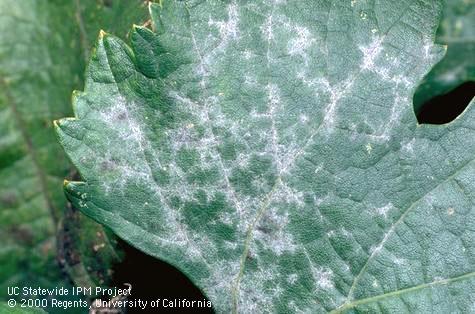
Powdery mildew (Erysiphe necator) on grape leaf. Photo by Jack Kelly Clark.
Powdery Mildew (Erysiphe necator)
As the name suggests, Powdery Mildew is most often caught in the early phases as a powdery white looking substance on the leaves of the vine. If the infection becomes worse, this powdery appearance can spread to the berries, along with blackening lesions along the stems. Berries that have been infected with powdery mildew should not be harvested for winemaking, as they impart a noticeable musty odor to the wine. There are a few fungicides that are effective in treating powdery mildew once you have an infection, but you should also take steps to prevent its spread by ensuring there is adequate sunlight exposure and airflow in your vineyard’s canopy.
Anthracnose (Elsinoe ampelina)
Anthracnose — also commonly known as “blackspot” or “bird’s eye rot” — is a fungal disease that tends to flourish during warm, wet seasons. While it can attack all non-woody parts of the grape vine, it is particularly noticeable on leaves, young stems, and berries. Infected shoots and leaves may first appear as reddish brown, purple, or black spots that typically turn grey and eventually grow into larger lesions with raised margins and a somewhat dead appearance. The center of these lesions will often turn grey or brown and fall out, creating a “shothole” appearance. Some leaves may become distorted, shriveling to the point of dying. Berry infections begin as small brownish spots that will develop a sunken appearance and a grey dot in the center of the wound, giving it a “bird’s eye” appearance (hence the common name). Anthracnose can reduce the quality and quantity of fruit harvested from each vine, and can even significantly weaken the vine itself. As with most fungal infections, the best treatment is to design and maintain the canopy in a way that promotes airflow. This will allow for faster drying after rainfall and better penetration of foliar fungicides. The preferred fungicide treatment for Anthracnose is an application of lime-sulfur in the spring when buds are still dormant, but as lime-sulfur has become more difficult to obtain, Captan has become a suitable substitute.
The images below show the different manifestations of anthracnose throughout the grapevine. Photos courtesty of Texas A&M University's Agriculture and Life Sciences Department.

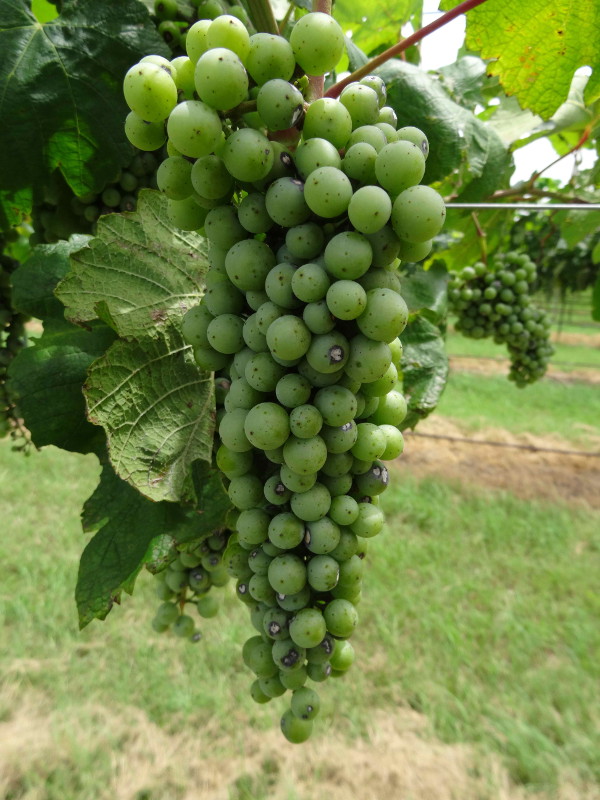
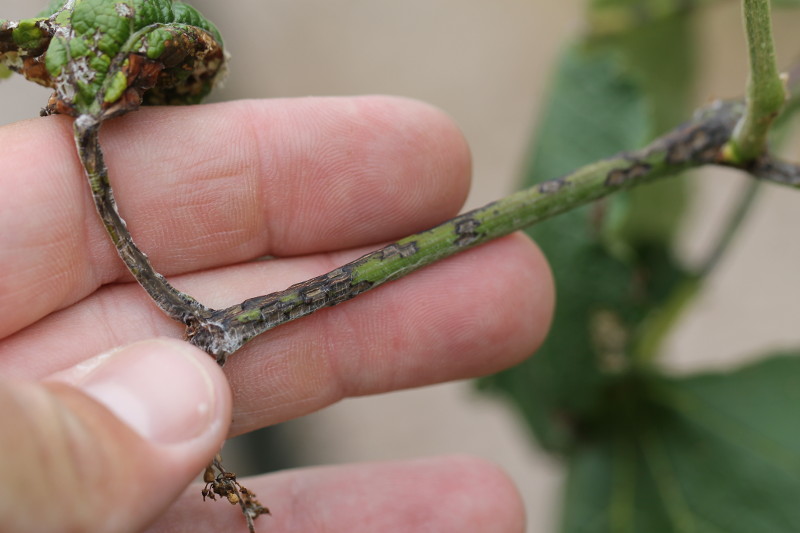
Botrytis Bunch Rot (Botrytis cinerea)
Botrytis — also known as “grey mold” — is a common fungal disease that can be particularly devastating for table grapes and other cultivars with tight clusters (though all cultivars are susceptible). While this fungus is assumed to be present in most vineyards around the country, the drier regions of Montana rarely experience the full force of this fungal infection. Botrytis overwinters in grape mummies and other organic debris around the vineyard, becoming active in early spring as soon as moisture and airflow allow its spores to spread to living hosts. The first effects can be observed in foliage, often causing shoots and buds to turn brown and necrotic, with leaves exhibiting large, reddish-brown patches. In moist conditions, you might also find some grey mold on foliage along with. Infections that reach the flower clusters can cause flower drop in spring, negatively affecting yields later in the season. But the more common issue (also affecting yield) is infection of berries in late summer. Botrytis typically infects berries that have already been wounded by something else (e.g. birds, insects, hail, powdery mildew, etc.), but it has been known to penetrate the skin of healthy berries, as well. As berries ripen, the most visible symptoms of the infection start to show up, with berries softening and growing a whitish-grey mold. Berries might even change color, eventually shrivelling to become the hardened “mummies” on the vineyard floor in which the fungus can overwinter again. Fortunately, botrytis can be controlled quite successfully through cultural practices — i.e. maintaining airflow in the canopy, keeping the vineyard clean of infected debris, etc.

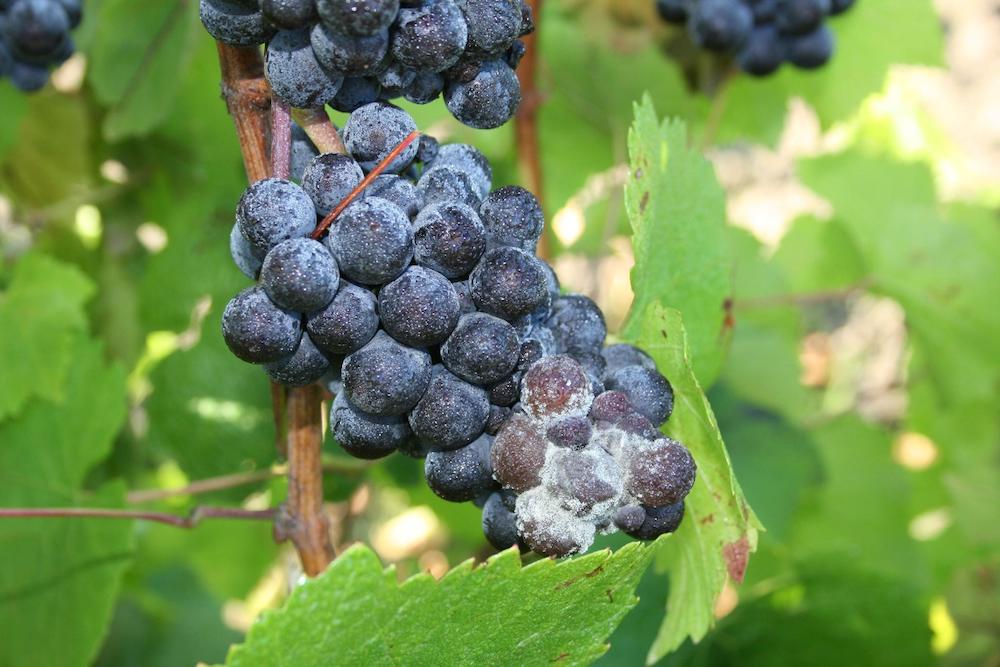
Chardonnay cluster with Botrytis infection in the middle of the cluster. Often infections appear to emerge from the inside out, as conditions become conducive fungal growth post-veraison. (Oregon State University Extension, photo by Patty Skinkis.)
Pinot noir cluster with Botrytis infection at the lower tip of the cluster. (Oregon State University Extension, photo by Patty Skinkis.)
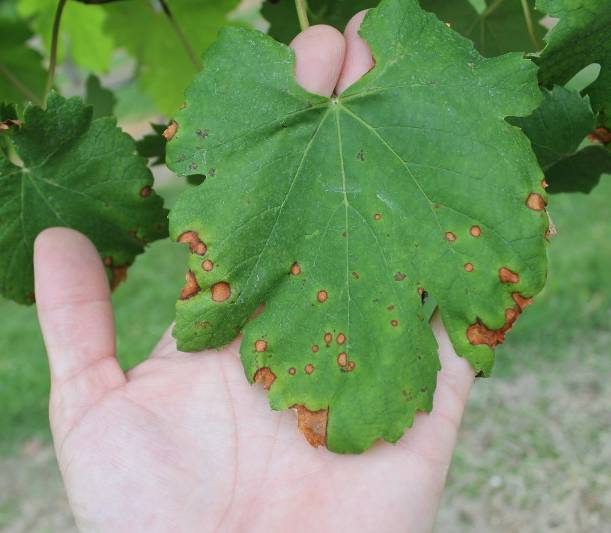
Black rot evidence on grape leaf. (Photo courtesy of Texas A&M University.)
Black Rot (Guignardia bidwellii)
Black Rot is a fungal disease that appears first on the leaves as tan spots that are encircled by a reddish brown margin. Eventually, you may see fungal fruiting bodies forming along these margins. The worst damage occurs on the berries, where Black Rot will appear on green berries as a small white spot surrounded by a brown ring. These rotten spots will grow and eventually the berries will shrivel and turn into “mummies,” or hard, raisin-like structures that are still attached to the cluster. You will likely see fungal fruiting bodies on these mummies, and the disease will continue to spread through these infected tissues. While Black Rot is not common in Montana, it is becoming an increasing and particularly devastating threat to vineyards in North Dakota, so it is important to keep an eye out for any signs of this disease making its way into Montana vineyards.
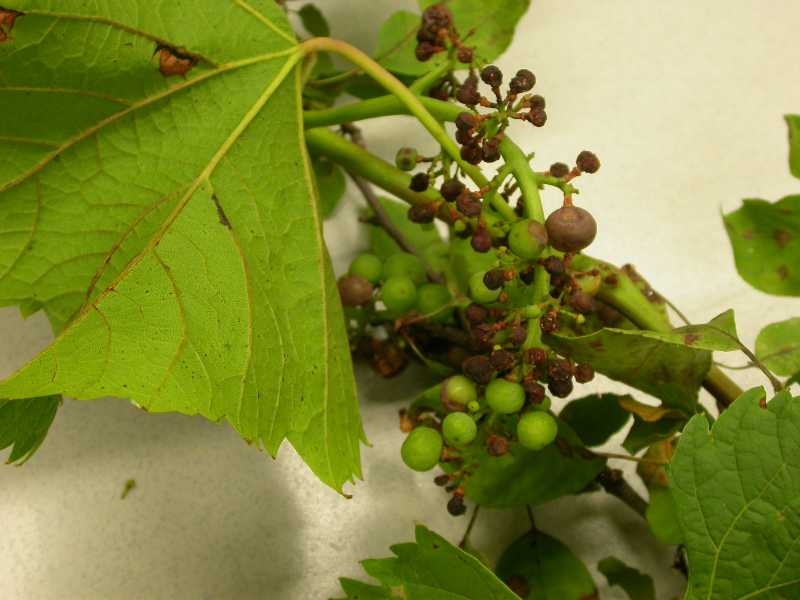
Black, scabby spots on green, unripe grapesand black, shriveled, "mummified" fruit. (Photo courtesy of Missouri Botanical Garden.)

Typical black, scabby spots on green, unripe grapes caused by black rot of grapes (arrested development). (Photo courtesy of Missouri Botanical Garden.)
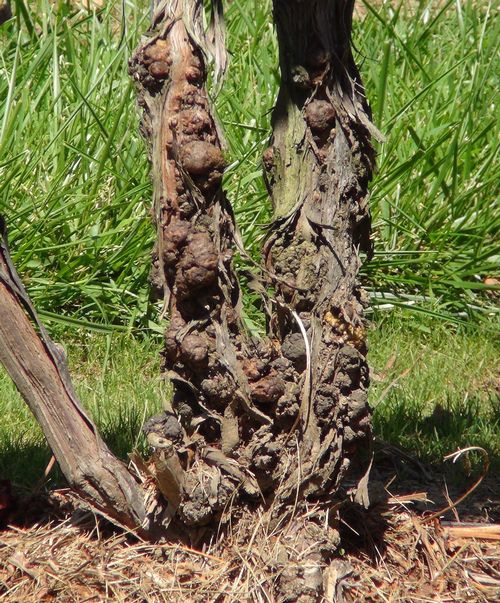
Visible symptoms ofcrown gall on the trunk of a mature grapevine. (Photo courtesty of Michigan State University.)
Crown Gall (Agrobacterium vitis)
Crown Gall is one of the rare bacterial diseases that affect grapes. The bacteria actually lives systematically within the plant until a significant stress or injury occurs from things like freezing, hail, pruning, or other mechanical processes in the vineyard. Once the bacteria has a convenient site of infection, it will co-opt the plant’s DNA and start reproducing cells rapidly, forming tumors or galls near the infection site. These galls — which are easily recognizable by the dark, corky material that forms at the damage site — will typically form lower on the trunk, but they can appear higher up, as well. Eventually, they can girdle the vine, preventing nutrient and water flow throughout the plant. It is possible to renew the vine using buds or suckers forming below the gall, but anything at or above the lowest gall should be pruning out. Because this disease does not have any ideal chemical treatments pre- or post-infection, it is important to be extra careful when pruning, weeding, or using any other tools or machinery in the vineyard, so as to avoid injuring the trunk and making it susceptible to Crown Gall. It is also best practice to remove any infected prunings from the vineyard.
For a fairly comprehensive list of weed control options, herbicides, fungicides, and other pest control methods, you can also refer to the following resources:
- Annual Weed Control in Vineyards (Rutgers University Plant & Pest Advisory)
- Pest Control in Small Vineyards (PDF) (Michigan State University Extension)
- Growing Grapes in Minnesota: Vineyard Pest Management (PDF) (Minnesota Grape Growers Association, Table 37)
- Growing Grapes in North Dakota (PDF) (North Dakota State University Extension, p. 10-14)
- NE Small Fruit Management Guide - Grape Diseases (UMass Extension Fruit Program)

